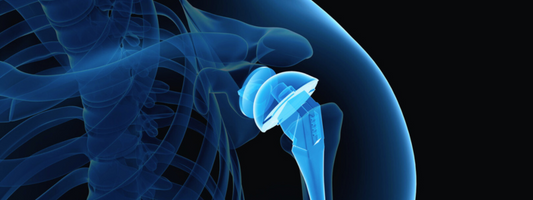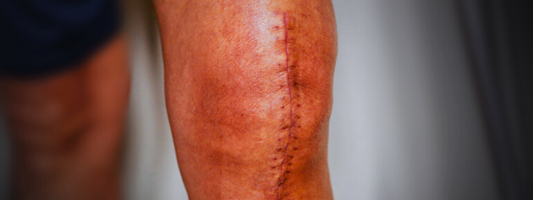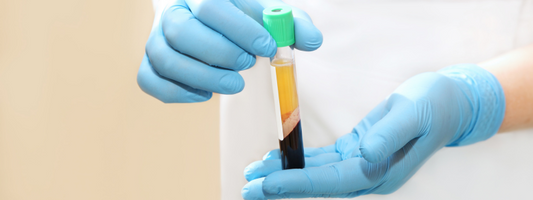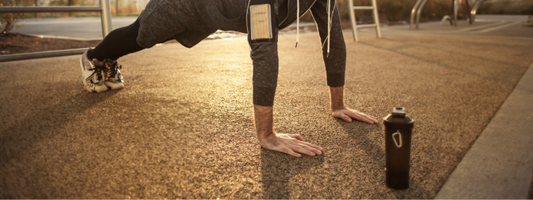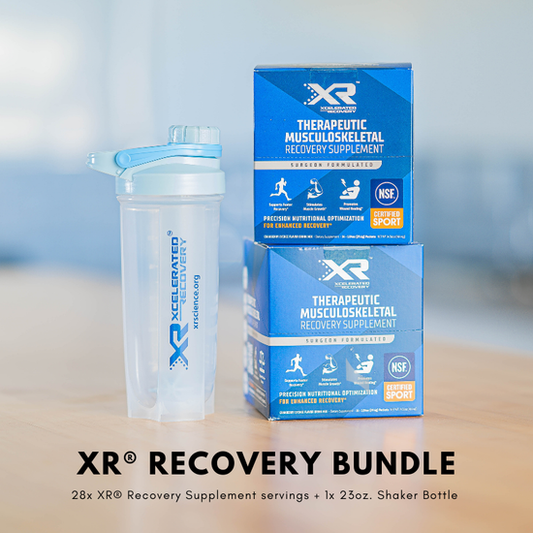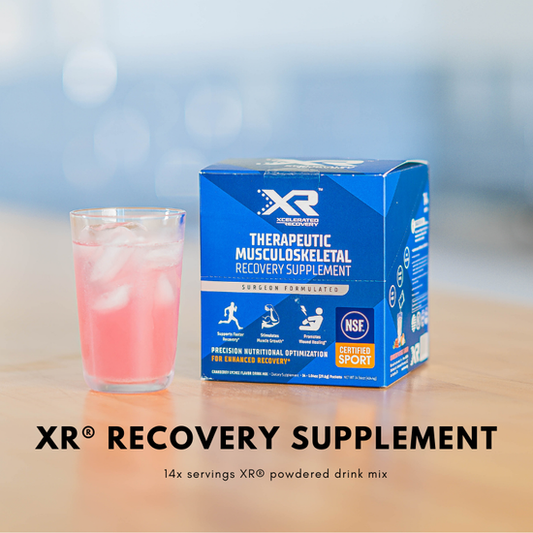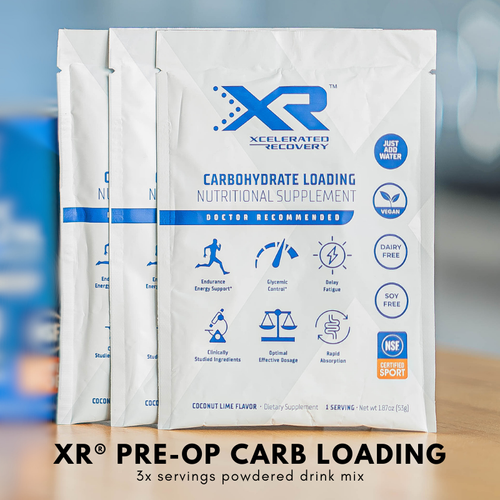
Optimizing Recovery from Achilles Tendon Injury and Surgery: A Nutritional Approach
Share
Achilles tendon injuries present significant challenges in orthopedic recovery due to the tendon's limited vascularity and the substantial mechanical demands placed upon it. Surgical intervention, while often necessary, introduces additional metabolic stress, increasing the risk of delayed healing, wound complications, and rapid muscle atrophy, particularly during periods of restricted weight-bearing. Recent evidence supports the use of targeted amino acid supplementation to address these challenges effectively.(1)

Physiological Challenges in Achilles Tendon Healing
The healing process of the Achilles tendon involves inflammation, proliferation, and remodeling phases. However, its hypovascular nature impedes efficient nutrient delivery, slowing collagen deposition and increasing the risk of complications such as wound dehiscence or tendon elongation. In older patients, factors like impaired stem cell response and anabolic resistance further delay recovery.
Studies have documented significant muscle atrophy following Achilles tendon rupture or surgery. For instance, research indicates that muscles connected to ruptured tendons exhibit a 65% decline in muscle force 14 days post-injury, a reduction that persists for up to 60 days.(2) Additionally, calf muscle atrophy ranging from 13% to 28% and strength losses up to 50% within the first six weeks have been reported, often persisting long after tendon healing.(3)
The Importance of Preop Optimization
The preoperative period offers a critical opportunity to prepare the body for recovery. In elective total knee arthroplasty (TKA), patients who received essential amino acid (EAA) supplementation for one week prior to surgery exhibited increased satellite cell activation.(4) These muscle stem cells are vital for repair and hypertrophy. Postoperatively, these patients demonstrated reduced muscle atrophy and faster recovery of strength and mobility. (5)This concept is directly applicable to Achilles tendon surgery, where immobility and disuse can rapidly trigger muscle catabolism.
XR® Formulation: Targeted Nutritional Strategy
The Xcelerated Recovery® musculoskeletal recovery supplement combines key amino acids and metabolic cofactors tailored to meet the physiological demands of tendon healing and muscle preservation:
1. Ca-HMB (Calcium β-Hydroxy β-Methylbutyrate): Ca-HMB, a metabolite of the essential amino acid leucine, has garnered significant attention in the realm of muscle health and athletic performance. Its primary mechanism of action lies in its ability to reduce muscle protein breakdown, a catabolic process that occurs naturally but can be accelerated by factors such as aging, injury, and strenuous exercise. By mitigating muscle protein breakdown, Ca-HMB helps to preserve muscle mass and promote muscle recovery.(6)
2. Synergistic Effects with Vitamin D: Research has shown that Ca-HMB's efficacy is further enhanced when combined with Vitamin D. Vitamin D plays a crucial role in muscle function by facilitating calcium absorption and regulating muscle protein synthesis. When paired with Ca-HMB, Vitamin D helps to maintain muscle mass and strength, particularly during periods of disuse or limited mobility, such as bed rest, injury rehabilitation, or sedentary lifestyles. This combination may also be beneficial for older adults who are at a higher risk of muscle loss and sarcopenia.(7)
3. L-Arginine & L-Arginine Alpha-Ketoglutarate (AAKG): These amino acids play a crucial role in stimulating the production of collagen, a vital protein for tendon repair and overall wound healing. Collagen provides structural support and tensile strength to tendons, facilitating their recovery from injury.(8)
L-Arginine and AAKG enhance nitric oxide (NO) production. NO is a signaling molecule that promotes vasodilation, leading to increased blood flow to the injured area. This enhanced blood flow delivers essential nutrients and oxygen, while also removing metabolic waste products, thereby accelerating the healing process. Improved vascularization also supports the formation of new blood vessels, which is crucial for tissue regeneration and wound repair.(9)
L-Arginine and AAKG may also contribute to reducing oxidative stress and inflammation, which can impede the healing process. By modulating the immune response and promoting a balanced inflammatory response, these AAs create a favorable environment for tissue repair and regeneration.(10)
4. Essential Amino Acids: EAAs play a vital role in maintaining and rebuilding lean muscle mass, which is crucial for surgical recovery. During the postoperative period, patients often experience a decrease in physical activity and an increase in metabolic stress, leading to muscle breakdown (catabolism). Supplementing with essential amino acids can help counteract these catabolic effects and promote muscle protein synthesis, leading to improved recovery outcomes.(11,12,13)
Specifically Leucine is a key EAA, which Activates mTOR signaling and stimulates satellite cell proliferation, priming muscle tissue preoperatively as well as aiding in faster muscle recovery postoperatively. Collectively, EAAs have multiple effects on recovery
- Protein Synthesis: Essential amino acids provide the building blocks for protein synthesis, which is essential for repairing damaged tissues and building new muscle.
- Anti-Catabolic Effects: By providing a readily available source of amino acids, supplementation can help prevent muscle breakdown and preserve lean body mass.
- Immune Function: Essential amino acids are also crucial for immune function, which is often compromised after surgery. By supporting immune function, these amino acids can help reduce the risk of infection and promote wound healing.
- Enhanced Recovery: Adequate intake of essential amino acids has been shown to improve overall recovery outcomes, including reduced length of hospital stay, improved muscle strength, and enhanced functional capacity.
5. L-Citrulline: Citrulline serves as a precursor to arginine and enhances nitric oxide production. Studies suggest that citrulline plays a direct role in fracture healing and collagen matrix formation. In tendon injury models, citrulline supplementation has been shown to accelerate fibroblast proliferation and improve tensile strength—making it particularly relevant for Achilles tendon recovery.(14)
6. Cystine and Glutamine: Cystine and glutamine play crucial, multifaceted roles in supporting the body's natural healing processes, particularly within the context of Achilles tendon injury and the subsequent surgical repair. Their combined benefits contribute significantly to immune modulation, oxidative stress control, and cellular regeneration.(15)
- Inflammation Control: By modulating the immune response and controlling oxidative stress, cystine and glutamine help manage inflammation, reducing pain and swelling and promoting a more favorable environment for tissue repair.(16)
- Collagen Synthesis: Collagen is the primary structural protein in tendons, and its synthesis is essential for tendon repair. Cystine, as a precursor to cysteine, is a key component of collagen, while glutamine provides energy and supports protein synthesis.
- Cell Proliferation and Differentiation: Glutamine plays a crucial role in cell proliferation and differentiation, processes essential for the formation of new tendon cells and the regeneration of tendon tissue.
- Tissue Remodeling: Both cystine and glutamine contribute to tissue remodeling, the final phase of healing, ensuring the repaired tendon is strong, functional, and resistant to re-injury.
7. Creatine Monohydrate: Supports rapid ATP regeneration, enhancing cellular energy availability during high-demand periods such as post-operative rehabilitation. This is particularly relevant in Achilles tendon injuries, where prolonged immobilization and disuse can lead to significant muscle atrophy and loss of strength.(17) When combined with progressive resistance training, creatine supplementation has been shown to improve muscle strength and mass recovery, factors critical for restoring calf muscle function and facilitating a return to weight-bearing and dynamic activities during Achilles tendon healing and post-surgical recovery.(18)
Protocol for Enhanced Surgical Recovery
To maximize benefits, targeted supplementation should begin one week prior to surgery to prime the muscle and tendon environment and continue for at least two weeks postoperatively, when catabolic demand peaks and muscle loss accelerates.(19) This 3-week protocol spans the most critical window for tendon healing and functional preservation. Extended use may offer additional benefits during longer rehabilitation timelines.(20)
Achilles tendon surgery has traditionally been associated with prolonged recovery, wound complications, and significant muscle atrophy. However, advancements in surgical techniques, combined with strategic nutritional supplementation such as the XR® formulation, have transformed the recovery landscape. By initiating XR® preoperatively and continuing through the early postoperative period, orthopedic teams can facilitate faster recovery, better muscle preservation, and reduced complications, enabling a more efficient and confident return to sport or daily activities.
References:
- Jazayeri R, Anil U, Zuckerman JD. The Role of Amino Acid Supplementation in Orthopaedic Surgery. J Am Acad Orthop Surg. 2024 Feb 15;32(4):162-168. doi: 10.5435/JAAOS-D-23-00300. Epub 2023 Dec 28. PMID: 38165904.
- Mashimo, S., Nozaki, T., Amaha, K., Tanaka, K., Kubota, J., Sato, H., & Kitamura, N. (2023). Quantitative Assessment of Calf Muscle Volume, Strength, and Quality After Achilles Tendon Rupture Repair: A 1-Year Prospective Follow-up Study. The American Journal of Sports Medicine, 51, 3781-3789. https://doi.org/10.1177/03635465231206391.
- Heikkinen, J., Lantto, I., Piilonen, J., Flinkkilä, T., Ohtonen, P., Siira, P., Laine, V., Niinimäki, J., Pajala, A., & Leppilahti, J. (2017). Tendon Length, Calf Muscle Atrophy, and Strength Deficit After Acute Achilles Tendon Rupture: Long-Term Follow-up of Patients in a Previous Study. The Journal of Bone and Joint Surgery, 99, 1509–1515. https://doi.org/10.2106/JBJS.16.01491.
- Muyskens JB, Foote DM, Bigot NJ, Strycker LA, Smolkowski K, Kirkpatrick TK, Lantz BA, Shah SN, Mohler CG, Jewett BA, Owen EC, Dreyer HC. Cellular and morphological changes with EAA supplementation before and after total knee arthroplasty. J Appl Physiol (1985). 2019 Aug 1;127(2):531-545. doi: 10.1152/japplphysiol.00869.2018. Epub 2019 Jul 25. PMID: 31343947; PMCID: PMC6732445.
- Dreyer HC, Owen EC, Strycker LA, Smolkowski K, Muyskens JB, Kirkpatrick TK, Christie AD, Kuehl KS, Lantz BA, Shah SN, Mohler CG, Jewett BA. Essential Amino Acid Supplementation Mitigates Muscle Atrophy After Total Knee Arthroplasty: A Randomized, Double-Blind, Placebo-Controlled Trial. JB JS Open Access. 2018 Jun 4;3(2):e0006. doi: 10.2106/JBJS.OA.18.00006. PMID: 30280129; PMCID: PMC6145559.
- Standley, R., Distéfano, G., Pereira, S., Tian, M., Kelly, O., Coen, P., Deutz, N., Wolfe, R., & Goodpaster, B. (2017). Effects of β-hydroxy-β-methylbutyrate on skeletal muscle mitochondrial content and dynamics, and lipids after 10 days of bed rest in older adults. Journal of Applied Physiology, 123(5), 1092-1100. https://doi.org/10.1152/japplphysiol.00192.2017.
- Rathmacher, J., Pitchford, L., Stout, J., Townsend, J., Jäger, R., Kreider, R., Campbell, B., Kerksick, C., Harty, P., Candow, D., Roberts, B., Arent, S., Kalman, D., & Antonio, J. (2024). International society of sports nutrition position stand: β-hydroxy-β-methylbutyrate (HMB). Journal of the International Society of Sports Nutrition, 22. https://doi.org/10.1080/15502783.2024.2434734.
- Ozdemir, M., Birinci, B., Haberal, B., Şimşek, E., Terzi, A., Balçık, B., & Yaradılmış, Y. (2024). The effect of L-Arginine therapy on achilles tendon healing: A histological and biomechanical investigation in an animal model. Foot and Ankle Surgery: Official Journal of the European Society of Foot and Ankle Surgeons. https://doi.org/10.1016/j.fas.2024.05.019.
- Zhao, Y., Jiang, Q., Zhang, X., Zhu, X., Dong, X., Shen, L., Zhang, S., Niu, L., Chen, L., Zhang, M., Jiang, J., Chen, D., & Zhu, L. (2021). l-Arginine Alleviates LPS-Induced Oxidative Stress and Apoptosis via Activating SIRT1-AKT-Nrf2 and SIRT1-FOXO3a Signaling Pathways in C2C12 Myotube Cells. Antioxidants, 10. https://doi.org/10.3390/antiox10121957.
- Ueyama, H., Kanemoto, N., Minoda, Y., Taniguchi, Y., & Nakamura, H. (2020). 2020 Chitranjan S. Ranawat Award: Perioperative essential amino acid supplementation suppresses rectus femoris muscle atrophy and accelerates early functional recovery following total knee arthroplasty. The Bone & Joint Journal, 102-B(6_Supple_A), 10-18. https://doi.org/10.1302/0301-620X.102B6.BJJ-2019-1370.R1.
- Ueyama, H., Kanemoto, N., Minoda, Y., Taniguchi, Y., & Nakamura, H. (2023). Perioperative Essential Amino Acid Supplementation Facilitates Quadriceps Muscle Strength and Volume Recovery After TKA. The Journal of Bone and Joint Surgery, 105, 345-353. https://doi.org/10.2106/JBJS.22.00675.
- Brown, E., Mohler, S., Kviatkovsky, S., Blake, L., Hill, J., Stambough, J., & Inclan, P. (2025). Amino Acid Supplementation May Help Prevent Muscle Wasting After Orthopedic Surgery, but Additional Studies Are Warranted: A Systematic Review of Randomized Clinical Trials. HSS Journal: The Musculoskeletal Journal of Hospital for Special Surgery, 15563316241308265. https://doi.org/10.1177/15563316241308265.
- Nauta, S., Greven, J., Hofman, M., Mohren, R., Meesters, D., Möckel, D., Lammers, T., Hildebrand, F., Siegel, T., Cuypers, E., Heeren, R., & Poeze, M. (2024). Mass Spectrometry Reveals Molecular Effects of Citrulline Supplementation during Bone Fracture Healing in a Rat Model. Journal of the American Society for Mass Spectrometry, 35, 1184-1196. https://doi.org/10.1021/jasms.4c00028.
- Arribas-López, E., Zand, N., Ojo, O., Snowden, M., & Kochhar, T. (2021). The Effect of Amino Acids on Wound Healing: A Systematic Review and Meta-Analysis on Arginine and Glutamine. Nutrients, 13. https://doi.org/10.3390/nu13082498.
- Okamoto, H., Taniyama, Y., Sakurai, T., Kodama, G., Sato, C., Fukutomi, T., Ozawa, Y., Ishida, H., Koseki, K., Yamauchi, T., Nakano, T., Unno, M., & Kamei, T. (2022). Perioperative Administration of Cystine and Theanine Suppresses Inflammation and Facilitates Early Rehabilitation and Recovery after Esophagectomy: A Randomized, Double-Blind, Controlled Clinical Trial. Nutrients, 14. https://doi.org/10.3390/nu14112319.
- Hespel, P., Eijnde, O., Leemputte, M., Ursø, B., Greenhaff, P., Labarque, V., Dymarkowski, S., Hecke, P., & Richter, E. (2001). Oral creatine supplementation facilitates the rehabilitation of disuse atrophy and alters the expression of muscle myogenic factors in humans. The Journal of Physiology, 536. https://doi.org/10.1111/j.1469-7793.2001.0625c.xd.
- Harmon, K., Stout, J., Fukuda, D., Pabian, P., Rawson, E., & Stock, M. (2021). The Application of Creatine Supplementation in Medical Rehabilitation. Nutrients, 13. https://doi.org/10.3390/nu13061825.
- Hirsch, K., Wolfe, R., & Ferrando, A. (2021). Pre- and Post-Surgical Nutrition for Preservation of Muscle Mass, Strength, and Functionality Following Orthopedic Surgery. Nutrients, 13. https://doi.org/10.3390/nu13051675.
- Ogawa, M., Yoshida, N., Satomi-Kobayashi, S., Tsuboi, Y., Komaki, K., Wakida, K., Gotake, Y., Inoue, T., Tanaka, H., Yamashita, T., Sakai, Y., Izawa, K., Takahashi, M., Ogawa, W., & Hirata, K. (2019). Efficacy of preoperative amino acid supplements on postoperative physical function and complications in open heart surgery patients: A study protocol for a randomized controlled trial. Journal of Cardiology. https://doi.org/10.1016/j.jjcc.2019.03.011.
- Ozdemir, M., Birinci, B., Haberal, B., Şimşek, E., Terzi, A., Balçık, B., & Yaradılmış, Y. (2024). The effect of L-Arginine therapy on achilles tendon healing: A histological and biomechanical investigation in an animal model. Foot and Ankle Surgery: Official Journal of the European Society of Foot and Ankle Surgeons. https://doi.org/10.1016/j.fas.2024.05.019.

